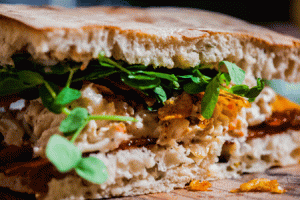Crab with Orval and Leeks
 Crab meat is a treat. Whether steamed or boiled in beer (along with some aromatics and herbs), the meat is a delicacy. Once removed from the shell and mixed with flavorings, this protein can become crab cakes, a killer crab sandwich, or a seafood bisque. Yet so many times I’ve had a crab dish and the delicate flavor of the crab is overpowered, not supported and enhanced, by the additional ingredients. This is why I created this recipe for Crab with Orval and Leeks.
Crab meat is a treat. Whether steamed or boiled in beer (along with some aromatics and herbs), the meat is a delicacy. Once removed from the shell and mixed with flavorings, this protein can become crab cakes, a killer crab sandwich, or a seafood bisque. Yet so many times I’ve had a crab dish and the delicate flavor of the crab is overpowered, not supported and enhanced, by the additional ingredients. This is why I created this recipe for Crab with Orval and Leeks.
Drawing on the elements that make Orval such a singular brew, this recipe showcases the Brettanomyces yeast profile. An aged or cellared version of this Trappist brew, with its subdued hop profile, increases the earthy funk from the additional time on the yeast. This flavor profile is further enhanced with the addition of white miso, adding an extra umami kick and fermented depth, all the while holding on to the sweet and succulent crab flavor.
This base recipe can be used many different ways. I mention a few different variations below, but other recipes that draw on this flavor profile could transform it into something else entirely. Try this recipe with White Miso Roasted Salmon Filet Topped with Crab or Decadent Crab Sandwich for Two.
Serves: 2

To learn more about Brasserie d’Orval, check out my photo essay.
Adapted from BeerAdvocate Magazine: Cuisine à la Bière | Feb 2016 | Issue #109
- 4 tablespoon butter, unsalted preferably European style
- 1 each leek cut in half, washed and sliced
- 1 tablespoon thyme, fresh leaves only
- 1 tablespoon miso, white available in many grocery stores
- 8 ounce Orval from Brasserie d’Orval, preferably aged over 6 months
- 1 cup cream preferably organic
- 1 pound crab meat, preferably Dungeness or King, saving the shells for stock
- sea salt to taste
- white peppercorns, freshly cracked, to taste
- 2 tablespoon parsley, Italian leaf chopped
- In a medium saucepan over medium heat, melt the butter.

- Once it starts to bubble, add the prepared leeks and lightly season with salt. Using a spatula, toss to coat in the fat. Cook slowly for the next 5 minutes, stirring frequently, to wilt the leeks. Add the thyme and white miso and let it dissolve and caramelize with the leeks. Stir and continue to cook for another 5 – 7 minutes, or until the leeks are tender and soft, but still hold their texture. Deglaze with the Orval, preferably aged over 6 months (saving the remaining brew for the chef’s enjoyment) and let the beer reduce until an almost syrupy consistency is reached, about 5 minutes. Add the cream and continue to reduce again, about 5 minutes. The final sauce should be thick and full of earthy funky flavors, coating the back of a spoon.

- Place the picked crab in a bowl (saving the shells to make a seafood stock), then add the slightly cooled sauce and the parsley.

- Lightly toss or fold the crab into the sauce to coat the meat, leaving any larger chunks intact, keeping the meat from dissolving. The sauce is ready to use, whether it’s warm over a White Miso Roasted Salmon Filet Topped with Crabor cold in a Decadent Crab Sandwich for Two.

- Beer Pairing: With all of the earthy, funky flavors in the dish, along with the seafood sweetness, a bright Saison | Farmhouse Ale, Tripel work as a compare beer pairing while a sour ale or Orval will pair nicely as a contrasting beer pairing. The yeasty elements of these styles will accentuate the miso and the Brettanomyces attributes.
Recipe Variations:
- Crab Cakes: Allow the above recipe to cool, after the crab is added, then add 1/3 cup bread or cracker crumbs and a beaten egg and divide the mixture into four large cakes for an entrée (served atop a celery root puree or mashed potatoes) or 10 appetizer-sized cake rounds. Encrust each cake in panko bread crumbs. Fry over medium heat in a butter and olive oil blend for 3 minutes per side.
- Pasta Sauce: Pour this sauce over al dente pasta or risotto (made with seafood stock).
- Pasta Filling: Let the crab sauce cool completely. Make your favorite fresh pasta into sheets and add tablespoon-sized mounds of the mixture, topping with another sheet of fresh pasta, wetting the edges of the dough and sealing with a ravioli cutter or a sharp knife to make squares, triangles or other shapes.






